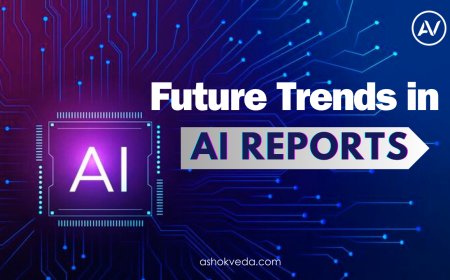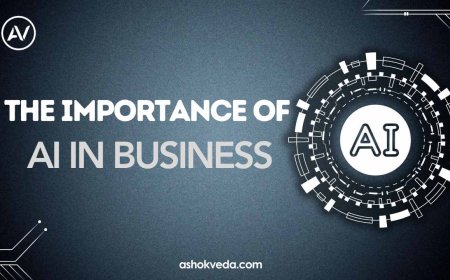What Are The Objectives Of AI?
Learn the primary objectives of AI, including automation, efficiency, decision-making, and innovation in various industries and applications.

Hey, Technology supporters! If you're interested in Artificial Intelligence (AI) and its objectives. AI is changing the world, making it more productive and innovative. But what exactly are AI's objectives? we'll look at the main objectives of AI, how it affects many fields, and what this suggests for the future.
Artificial intelligence is quickly changing the world, from improving everyday tasks to changing industries. But what are the main objectives of AI? Understanding these goals can help us understand how AI technologies are built and what they aim to achieve. we'll look at the core goals of AI, including important ideas such as machine learning, Data Science, and more to take and how to position yourself for success in the world of AI.
The Core Objectives of AI
1. Improve Decision-Making
One of the main objectives of AI is to improve decision-making processes. AI systems are designed to look at big datasets, detect patterns, and deliver insights that people may overlook. This skill is especially useful in industries such as healthcare, banking, and logistics, where making exact and quick choices is important. Organizations can use AI to improve operations, minimize risks, and make better-informed decisions.
2. Automate Routine Tasks
AI aims to automate regular and repetitive jobs, allowing human workers to focus on more difficult and creative tasks. This automation applies to a wide range of businesses, including manufacturing and customer service. For example, AI-powered chatbots can manage client inquiries, and robotic process automation (RPA) can automate administrative duties. By automating these functions, firms can boost efficiency.
3. Improving Natural Language Processing
Natural Language Processing (NLP) is an important objective of AI, allowing machines to understand and interact with human language. NLP includes tasks like text classification, sentiment analysis, and language translation. NLP applications include virtual assistants such as Siri and Alexa, chatbots for customer support, and improved search engines. The goal is to make human-computer interactions easier and more efficient.
4. Advances in Machine Learning and Data Science
AI is closely related to machine learning and Data Science, which include training computers to learn from data and predict outcomes. The idea is to create models that will improve with time as they are subjected to new data. This feature is essential in predictive analytics, where AI can estimate trends and behaviors based on past data. Companies apply these lessons to strategic planning, marketing, and risk management.
5. Empowering Computer Vision
Another important objective of AI is to improve computer vision, allowing machines to analyze and understand visual data. This involves identifying items, evaluating visuals, and even detecting emotions through facial expressions. Computer vision is employed in a wide range of applications, including driverless vehicles, medical imaging, and security systems. The goal is to give machines the ability to see and respond to their surroundings appropriately.
6. Personalized User Experiences
AI aims to create personalized experiences by evaluating user data and behavior. This objective appears in the recommendation systems employed by platforms such as Netflix, Amazon, and Spotify, which propose material based on user preferences. AI improves customer pleasure and engagement by adapting experiences to their specific requirements and goals.
7. Promoting Ethical AI Development
As AI technologies change, it is important to address moral issues. One of the main objectives is to make sure that AI systems are created and used properly. This includes reducing biases, safeguarding user privacy, and holding AI decisions accountable and transparent. Ethical AI development seeks to foster trust while ensuring that AI helps society as a whole.
8. Improving Safety and Security
Safety and security are important in AI development. AI systems must be built to be safe and secure, particularly when used in important domains such as healthcare, transportation, and finance. This goal includes thorough testing, constant monitoring, and the implementation of fail-safes to avoid unwanted outcomes.
9. Improving Human-AI Collaboration
Another objective of AI is to improve collaboration between humans and machines. AI aims to improve rather than replace human capabilities by developing computers that can collaborate with humans. This collaboration appears in fields such as augmented reality, where AI assists with design, training, and maintenance.
10. Driving Innovation
Finally, AI aims to drive innovation across multiple industries. AI technologies are pushing the boundaries of what is possible, creating new opportunities in research, engineering, and business. This includes creating new products, finding innovative solutions for complex issues, and promoting creativity.
Specific Objectives of AI in Different Fields
Healthcare
AI's objectives aim to transform healthcare by improving diagnoses, personalizing treatment approaches, and predicting patient outcomes. AI algorithms assess medical images, monitor patient vitals, and even assist with operations, all of which improve care quality.
Finance
In finance, AI improves fraud detection, risk management, and trading methods. AI systems evaluate market trends, detect suspicious activity, and automate financial planning, resulting in better and more efficient financial operations.
Education
AI is personalizing education by adapting learning materials to each student's requirements. AI-powered platforms personalize curriculum, track progress, and provide real-time feedback, assisting instructors in improving teaching methods and student outcomes.
Entertainment
AI's objectives are to promote media innovation by giving individualized content recommendations, creating realistic special effects, and even writing music. AI improves the user experience by making entertainment more interesting and customizable to individual preferences.
Manufacturing
AI helps optimize manufacturing operations by estimating maintenance needs, improving quality control, and automating repetitive tasks. Intelligent robots and AI systems increase production while decreasing downtime, making manufacturing more efficient and cost-effective.
How AI achieves these objectives
To achieve these objectives, AI uses some basic technologies and strategies.
-
Machine learning is the process of training algorithms on big datasets to find patterns and make predictions. Techniques include supervised learning, unsupervised learning, and reinforcement learning.
-
The Data Science field deals with obtaining insights from data through statistical methods, Data Analysis, and machine learning. Data scientists prepare data, create models, and evaluate the outcomes.
-
Natural language Processing (NLP) uses algorithms to analyze and comprehend human discourse. This includes syntax and semantic analysis, machine translation, and text production.
-
Computer vision is the use of algorithms to process and evaluate visual data from the real environment. Techniques include picture recognition, object detection, and facial recognition.
-
Robotics is the incorporation of artificial intelligence (AI) with mechanical systems to produce machines able to perform physical tasks. This includes self-driving automobiles, industrial robots, and drones.
Artificial intelligence is not simply a technology trend; it is an innovative force with extensive effects on every part of how we live. AI's goals include solving complicated issues and optimizing processes to increase creativity and ensure ethical progress. Understanding these objectives and how they are achieved allows us to better appreciate AI's potential and prepare for a future powered by intelligent systems. Stay interested, keep learning, and accept the amazing field of artificial intelligence!




































